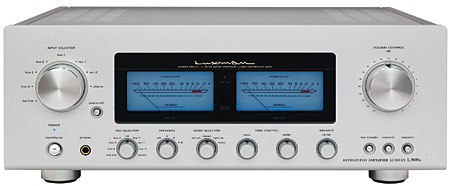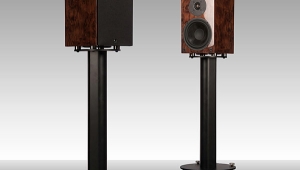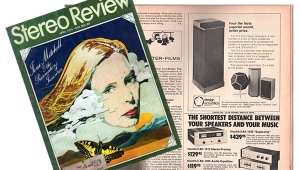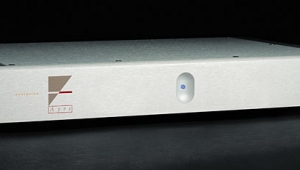| Columns Retired Columns & Blogs |
The Fifth Element #53 Page 2
I wonder if it's not essentially the same with stereo systems. Perhaps we can only learn the hard way that sound quality that draws you in and keeps you coming back for more is going to cost a certain, not very reducible amount of money. When I switched back to the budget systems described above after several weeks with the Luxmans and the Harbeth Compact 7s (admittedly, a 75% price cut), I was suddenly less interested in listening to recorded music for relaxation. Once I put something on, it sounded good enough, and I could respond to it, but I didn't have the same sense of wanting to hear discs I hadn't heard in a long time.
Footnote 2: A USB music input, as distinct from a USB input that serves only to allow updating of the unit's operating software.
Sad thing is, back in the long-ago days when I was shopping for stereo equipment, had a salesperson told me in good faith that I wouldn't ever really be happy until I bought a system costing four to five times what my comfort zone was at the time, I would have dismissed it as a sales ploy.
So, Problem No.1 is that our budget may be too low—that perhaps we may actually save money over the long haul by spending more now. On to Problem No.2.
To CD-receive, or not?
That is the question, and one worthy of the Prince of Denmark. CD or DVD receivers have obvious benefits. They are affordable. They are small. They require only one power cord and no interconnect cables. Mismatches of electrical sensitivity or impedance should be nonissues. The entire music system is operable from a single remote control. If such things matter to you, differing industrial design styles or faceplate colors on different chassis are also nonissues. And unlike "executive stereos," you get to choose your loudspeakers and speaker cables. All of this is to the good.

However, living with more than a half-dozen of them over more than a year has given me perspective as to when, despite the category's virtues, a CD receiver might not be the best choice.
First, if your total budget is closer to that Stereophile-reader average of $12,500–$15,000, you should get better sound quality by spending more. Luxman's L-505u integrated amplifier costs $3500—less than twice the prices of the more expensive CD receivers from Primare, Carat, and Arcam. The Luxman amp is head and shoulders over the CD receivers in terms of sonic authority, tactility, centeredness, continuity, easefulness, soundstage size, image specificity—you name it—and in spades. It's the difference between "This is pretty good" and "This is addictive." Luxman's L-505u integrated is my new default recommendation in integrated amplifiers, and at $3500, $$$ for exceptional value. Full coverage next time.
You might be able to close some of that price gap between a CD receiver and a higher-quality integrated amplifier by doing without FM radio—but by going to separates you also lose a primary benefit of a one-box. Horses for courses.
Second, related to the above: CD receivers don't really have an "upgrade path," except by getting rid of one and buying another. In theory, you could "upgrade" a CD receiver by connecting a new power amplifier to the CD receiver's preamplifier outputs (assuming the latter has such), but that defeats another central purpose of a one-box while adding another power cord, more interconnects, and another on/off switch.

Third, and related to the possibility of scrimping elsewhere to afford the Luxman: If the offerings on your local FM spectrum are jejune, or if you don't ever listen to FM radio except in your car, then when you buy a CD receiver, you're paying for a major function you won't use. The same goes if you listen primarily to satellite or digital radio rather than terrestrial FM: you'd be better off buying an integrated amplifier.
Fourth, if you're migrating to Internet radio or are loading your CD collection onto a music server, a CD receiver, especially one without a USB music input (footnote 2), is a serious misallocation of resources. Case in point: Carat's I57, my choice for best sound quality, not only lacks USB and S/PDIF inputs, it also lacks an S/PDIF output—so no CD ripping. I wouldn't be surprised if Carat's engineers were to reply that achieving the CD sound quality they do at that price means they had to do without the next-gen bells and whistles, and put the money into getting the best sound from legacy formats such as HDCD. It's also possible that the next-gen bells and whistles are things the target audience has little interest in—or, at least, the target audience doesn't plan on meeting those needs with a CD receiver.
Finally, the flip side of a CD receiver's one-box-ness is the risk that if its CD transport packs it in, you have to send the whole thing back for repair. Food for thought, all of it.
What to do now? Well, almost as if by magic (or rather, the genius of better-mousetrappery), an even newer product category has arisen, one that squarely addresses many of the above concerns about CD receivers' retro-format orientation and lack of future-proofedness. But keep in mind that, unless you're going to embrace Internet radio and/or a music server, a CD receiver might still be the optimal choice for you. And, increasingly, CD/DVD receivers are USB-ready.
This new product category as yet lacks a catchy name, as far as I know, but it combines in one chassis an integrated amplifier and a USB D/A converter. Omitting a disc transport and terrestrial radio not only saves money, it puts the potential mechanical Achilles' heel of a disc drive outside the main system box. (Nearly everyone has a CD transport or player with a digital output, or can cheaply acquire one, or can do without by loading CDs into a networked computer.)
Peachtree Audio seems to be betting the farm on this new wrinkle in high-performance audio convenience. Their new Nova 80Wpc integrated amplifier plus USB DAC ($1199) made its debut in January, at the 2009 Consumer Electronics Show; production units are expected soon. The styling is nifty—something of an homage to Eames Office design. Furthermore, both the Nova and its smaller sibling, the Decco, can function as docks for Sonos' ZP80 and ZP90 ZonePlayers. I have requested a review sample and will report ASAP.
Integra DSR-4.8 DVD receiver
Integra is the boutique division of Onkyo, and the DSR-4.8 is Integra's entry in the category of 2.1-channel DVD receivers. Its maker rates its power at 50Wpc into the nonstandard load of 6 ohms; my mental arithmetic suggests that that's somewhere near 33Wpc into 8 ohms. In addition to a full array of video features, such as HDMI HD conversion of internal DVD playback and HDMI pass-through, the DSR-4.8 boasts 24-bit/192kHz DACs, DTS and Dolby Digital converters, proprietary "virtual surround," and a variable subwoofer crossover. As far as I know, the DSR-4.8 is the only CD or DVD receiver that also plays SACDs (though not Blu-ray discs). An optional Remote Interactive dock allows remote control by an Apple iPod. The price is an arrestingly low $600.

The front-loading Integra DSR-4.8 has standard component dimensions (roughly 17" W by 3.5" H by 16.25" D) and weighs 19 pounds. It's the same height as the Arcam Solo Music and slightly less tall than the Carat I57. The design is visually elegant, the build quality very good. The large selector and volume knobs are polished aluminum, and are recessed into slightly larger openings in the faceplate of black aluminum; these openings are illuminated at the top by restful deep-blue lights. Such classy design cues, as well as the solid feel of the detented volume control, suggest a list price far higher than $600.
It's almost impossible not to like the DSR-4.8. How does Integra deliver so much performance for so little money? Listening to a one-off, noncommercial 24/96 DVD dub of the Cannonball Adderley/Miles Davis session that includes their famous "Autumn Leaves," using the Integra's headphone jack and Denon's ultraswank AH-D5000 closed-back cans ($700), I could hear the collaboration unfold in all its mixed-down-mono, slightly leaky, echo-chambered glory. Sweet. Listening to one of my "Records To Die For" for 2009—of Terje Boye Hansen leading soloists, choir, and the Kristiansand Symphony Orchestra in Sigurd Islandsmoen's Requiem (SACD, 2L 36SACD)—I had an impression of a very light, agile sound with great treble clarity but definitely lightweight bass. Quickly plugging the AH-D5000s into the Carat I57's headphone jack confirmed that impression.
Before, through loudspeakers, I compare the Integra DSR-4.8 with other contenders, there is one potential negative to deal with. Unlike all the other CD or DVD receivers in this quest, the Integra has a cooling fan, and that fan runs at a steady speed all the time. In my environment, it was audible—at least between tracks. I can only speculate why Integra went with a fan, but I suspect their expectation was that the DSR-4.8 would end up in professional or amateur home-theater systems in which ventilation might be inadequate over the long haul. It's possible that the fan noise will be a nonissue in your setup. Or you could rearrange your room so that the DSR-4.8 is far enough away from your listening position, and/or use intervening décor elements to block the sound path.
All of the following listening was done using PSB's Imagine B two-way bookshelf speakers ($1000/pair), which I profiled in my February column. The Imagine B offers exceptional value for money; I continue to be very impressed with it overall, even as I remain somewhat frustrated with its lack of deep bass extension—you can't have everything, I guess. In that respect, the Imagine B is the "poor relation" to Harbeth's HL-3P-ES2. The comparison is by no means absurd—at half the price, the PSB has many of the Harbeth's advantages and the same shortcoming: bass extension.
To give two musical examples: At moderate volumes, the PSBs didn't do justice to the string-bass introduction to "So What," from Miles Davis's Kind of Blue. There was just some vague, woolly thumping going on in the background. Neither did they allow the string-bass beats in Julie London's "I Surrender, Dear" (Time for Love: The Best of Julie London, CD, Rhino R2 70737), to underscore the extent to which the protagonist of the song has reached the end of her rope. A pounding heartbeat it was not. On the positive side of the ledger, the PSBs could "disappear" just as the Harbeths do—though not with as much coherence and tonal richness. Whether the increment of midrange tactility and suppleness the Harbeth offers is worth twice the money is a decision I can't make for you. (At CES 2009, Harbeth announced that the HL-3P-ES2 would soon be revised to ES3 status, with a new woofer-midrange driver.)
I chose Donald Fagen's The Nightfly (CD, Warner Bros. 23696-2) as my test disc, and as a baseline began with the Luxman DU-50 universal player and L-505u integrated amp. The first thing I established was that the PSB Imagine B really could take advantage of superior associated equipment. I'm sufficiently impressed by the Imagine B that I've asked John Atkinson to give it a listen and to publish its measured performance. With any luck, he won't find any reason to dust off the word horrendous (footnote 3). I urge JA not to restrict his listening to budget electronics. However, even higher-priced electronics didn't allow the Imagine B completely to escape its humble origins. The sax solo on "Maxine" (I assume it's the late Michael Brecker) lacked the necessary degree of urgency. It didn't grab me the way it does through more ambitious—and far more expensive—speakers.
Going straight from the $8500 Luxman combo to the $600 Integra DSR-4.8: not at all in the same class, but not completely shabby, either. The sound was noticeably lighter in heft, not as smooth, and a bit peaky in the upper midrange. Also, the music didn't seem to emerge from as deep in the noise floor—the presentation didn't stay together at the quiet end of the dynamic range (the cooling fan could have been part of the problem). On the positive side, the egg-shaker on "New Frontier" floated in space very nicely.
On balance, the sound of the PSB Imagine B and Integra DSR-4.8 combination was too forward for my taste, and, because tone controls are just about the only feature the DSR-4.8 lacks, that fix is out. The sound was detailed and dynamic, but lacked a bit in easeful flow. Your mileage may vary.
Integra's DSR-4.8 may not be the best solution for a music lover seeking to spend $2500–$3750 on his or her sole serious stereo, but it packs a lot of performance into a classy package at a great price. Keep it in mind for a den, dorm, or vacation-home system.
Footnote 2: A USB music input, as distinct from a USB input that serves only to allow updating of the unit's operating software.
Footnote 3: See JA's measurements of Eminent Technology's LFT-16. As far as I'm concerned, the LFT-16 remains a valid choice and excellent value for money; I preferred its sound to that of the more expensive Fried Compact 7, for instance. I expected its measurements to be somewhat funky, given the difficulty of integrating cone and panel drivers and the side-by-side mounting of tweeter and midrange. I just didn't expect the graphs to look that funky.
- Log in or register to post comments




































